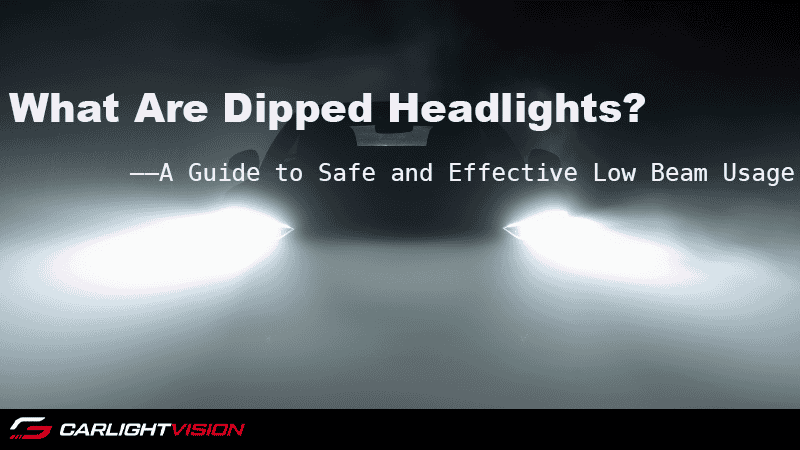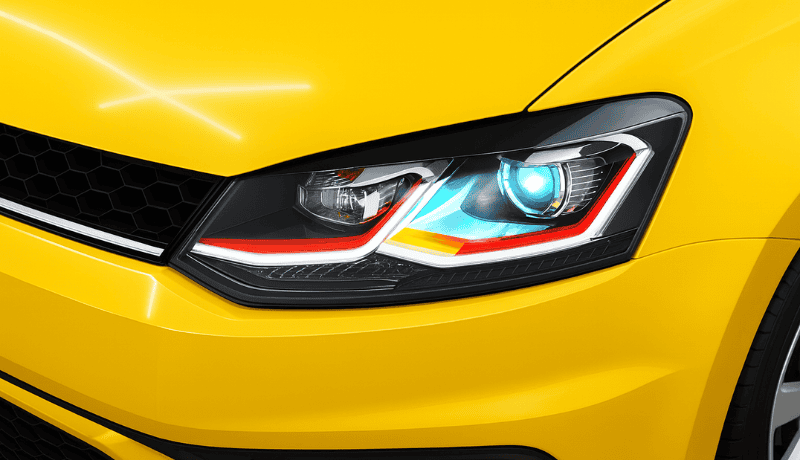Want to learn about low-beam headlight use? This blog post will walk you through the use of dipped headlights.
Understanding how dipped headlights are used can significantly boost your visibility during nighttime driving. With our expertise in the car lighting industry, we can help you understand the different aspects of using low-beam headlights.
Are you ready to explore safe driving with dipped headlights? Let’s get into the article.
What Are Dipped Headlights?

Dipped headlights are also called dipped beam headlights or low beams in various regions. These vehicle lights are designed to provide ample illumination on the road ahead. They have higher brightness than daytime running lights and sidelights. However, they do not emit sharp glare like that of full-beam headlights.
These are relatively low-intensity lights with beams focused downward towards the road. The directional setup prevents the light from blinding other road users. It makes them ideal for nighttime driving, heavy rain, fog, and other situations where visibility is reduced. In addition, they are linked to the rear tail light of your car. It makes your vehicle visible to other road users that are approaching.
How Dipped Beam Headlights Work?
Dipped headlights work by employing a combination of lenses and reflectors. They are located in the headlight unit. The reflectors collect and orient the light the bulb generates. A specialized lens redirects the light and focuses it into a unique beam pattern. After passing from the lens, the angle of the beam slightly bends downward. It helps improve the visibility of the road without causing discomfort to other drivers.

In addition to dipped headlights, your car has high-beam headlights. These lights are also known as main beam headlights. Unlike dipped headlights, high-beam headlights are designed to project an intense and broader light beam to illuminate the unlit road. These lights offer better visibility over long distances.
However, the intense brightness can cause significant glare. It works well for rural areas and inadequately lit places that have limited traffic. However, you can’t use them in urban areas with heavy traffic. The glare can affect the vision of oncoming traffic, leading to accidents.
In contrast, dipped headlights offer a safer solution in urban areas and during foggy or rainy weather. Their focused angle helps prevent light from reflecting at the driver in adverse conditions, maintaining visibility. Their balanced illumination makes them perfect for everyday driving in populated areas or where visibility is seriously reduced.
When to Use Dipped Headlights?

Knowing the right time to use dipped headlights is crucial for maintaining visibility and safety on the road. The Highway Code outlines the guidelines for the use of dipped beam headlights.
Nighttime Driving in Urban Areas
One primary situation to engage dipped headlights is during nighttime driving in built-up or urban areas. Street lighting offers inadequate illumination in these areas. Dipped headlights allow you to see the road ahead without causing discomfort to other road users.
Dull Daytime
These low-beam headlights are also necessary for driving during dull daytime. These lights provide illumination when natural light is reduced, but it’s not dark enough to need full headlights. The angled light beam provides the necessary visibility without overwhelming other road users. High beams are too intense for such situations. They can create a dangerous glare that temporarily blinds oncoming drivers.
Poor Weather Conditions
In addition, dipped headlights are essential during poor weather conditions, such as heavy rain, fog, or snow. When visibility falls below 100 meters, these headlights help illuminate the road. It helps you see potential obstacles and road signs while keeping the beam focused downward to avoid glare for other vehicles.

Overtaking Other Drivers
Using dipped headlights is also vital while overtaking other vehicles on the road. It prevents causing glare in the rear-view mirrors of vehicles you are passing. High-beam headlights can result in a temporary blinding effect. It can make it difficult for other drivers to maintain their lane and position.
However, dipped headlights have downwardly focused light. It prevents impacting the visibility of other road users. These lights offer comfortable visibility for the driver in front. You can switch to main beam headlights once you are level with other vehicles.
Headlight Beam Options
Vehicles are equipped with multiple types of headlights to address different visibility needs. Understanding these types allows you to efficiently use them. Here is an overview of various headlight beam options:
| Feature | Dipped Headlights | Main Beam Headlights | Fog Headlights |
|---|---|---|---|
| Beam Intensity | Low-intensity | High-intensity | Low-intensity |
| Orientation | Directed downward to minimize glare | Straight for extended road visibility | Directed downward to minimize glare |
| Usage | Driving at nighttime and in low-light conditions | Low-traffic and uncrowded areas | Fog, heavy rain, and snow |
| Glare | Minimum glare | High glare | Minimum glare |
Dipped Beam Headlights
Dipped beam headlights offer standard lighting for most driving situations. These headlights release a relatively low-intensity beam that lacks intense glare. These are oriented downward, preventing dazzling other road users. It promotes a safe driving environment by offering sufficient illumination. It also prevents other road users from distracting. It is the best solution for driving at nighttime and reduced visibility during the day.
Main Beam Headlights
Main beam headlights are known for their broader and more intense light beam than dipped headlights. They are designed for use in low-traffic areas with minimum visibility.
Full beams shine straight on the road, enabling you to see further down the road. They also help you spot potential obstacles. However, they pose safety concerns when used in crowded areas. It’s better to turn them off when approaching other cars.

Fog Headlights
These are another type of car headlights that are designed to boost visibility in fog, snow, or heavy rain. Other types of headlights are not suitable for illuminating the road in such conditions. They might reflect off the moisture and reduce visibility.
Fog lights are located on the lower side of the car. They provide a short, wide beam pattern that illuminates the road directly below the fog line. Their exclusive beam angle minimizes the glare. These lights are used in combination with other headlights, offering clear visibility in low-light conditions.
Headlight Bulb Options
Cars employ different types of headlight bulbs to accommodate various lighting needs. Headlights are of mainly two types, single filament bulbs and dual filament bulbs. The following is an overview of the two types of headlight bulbs:

Single Filament Bulbs
These headlight bulbs come with one filament and are used in the headlight unit. Cars that employ single filament bulbs require two separate bulbs for low-beam and main-beam lights. Each bulb serves a single function, resulting in clearer, dedicated lighting for each beam. These bulbs require specific fitting for each beam. Maintenance of this type of bulb is costly and more strenuous. In addition, some vehicles have different settings for each bulb, making it difficult to replace headlight bulbs.
Dual Filament Bulbs
This type of bulb has two filaments, one for dipped and the other for full-beam light. This design allows a single bulb to handle both functions. Most dual bulbs come with a 9003 (HB2/H4) fitting. This fitting is compatible with various car models. Replacing these bulbs is easier and more cost-effective, as you need to replace only one headlight bulb.
Adjusting and Maintaining Dipped Headlights
Adjusting and maintaining dipped headlights is imperative to ensure optimal performance. Here are some tips for maintaining and adjusting dipped headlights:
Determine The Headlight Setting
Determining the headlight setting is vital to ensure you are using the right light beam. Observe your instrument cluster to determine the headlight settings. Dipped beam headlights are represented by a yellow or green symbol. A blue icon with straight lines symbolizes high-beam headlights. Knowing the headlight setting is necessary to prevent blinding other road users.
Regularly Clean The Headlights
Regular cleaning of headlights is necessary for their efficient functioning. Dust, dirt, and smoke accumulate on the lens of headlights. It minimizes their brightness and effectiveness. Cleaning the lens regularly can prevent build-up and maintain clear illumination.
Replace The Headlight Bulb
Headlight bulbs wear out over time. Regularly inspect them to ensure optimal performance. If your headlight bulb fails or you observe any cracks on the lens, replace it immediately. It’s better to keep a spare bulb on hand to prevent unexpected issues on the road.

Upgrade to LED Bulbs
LED bulbs are more efficient and durable than traditional bulbs. Upgrading to high-quality bulbs can provide you with brighter light. They also last longer, reducing the need for frequent replacements and consistent performance.
Adjusting The Headlight Bulbs
Proper alignment of your headlight is key for ensuring effective illumination. The headlights displace over time. It results in dipped headlights pointing too high or too low. It can result in poor illumination during low-light situations. Some cars have built-in bubble levelers. They assist you in determining the right position for the headlight bulb. If your car doesn’t have a bubble leveler, you have to adjust them manually. You can also get professional assistance to adjust them.
Inspect The Electrical System
Regularly inspecting the electrical components of dipped headlights is another crucial aspect of maintaining them. Pay attention to frayed wires or loose connections, as these can disrupt power flow and often go unnoticed. They also cause dimming headlights. Regular inspection enables you to identify damaged wiring or faulty fuses. Replacing them in a timely manner can prevent electrical issues in other parts of your car.
Test The Headlight Switch
The headlight switch functions include turning the headlights on and off, and controlling between dipped and main beams. Test the switch if it’s working properly. Suppose the headlight switch doesn’t activate the lights, repair or replace it. Address this issue promptly to prevent compromised lighting.
Troubleshooting Common Issues

Issues in dipped beam headlights can compromise visibility and increase the risk of accidents. The following aspects will help you troubleshoot common issues with these headlights.
One or Both Headlights are Not Functioning
Sometimes one or both headlights of your car fail. If only a single headlight is out, it’s often due to a burnt-out bulb. You can fix it by replacing it. Operating a vehicle with a single functional headlight can mislead other drivers. It can lead to accidents, particularly in unlit areas.
If both headlights are out, the issue may lie with the fuse or the bulb. Check which component is damaged and replace it. If one or both headlights of your car are not working, you could be charged a fixed penalty notice of £100 by the law enforcement department.
Flickering Dipped Headlights
If your dipped headlights are flickering, you may have a loose or corroded connection. It may also occur due to a failing bulb. Inspect the electrical connections to ensure they’re functional and free from corrosion. If the issue is caused by the bulb, replace it with a new one.
Condensation in Headlight Housing
This is another common issue with dipped headlights. Condensation within the headlight housing can lead to reduced visibility and even bulb failure. It may also occur if the seal is damaged. Inspect the headlight assembly to figure out any gaps or cracks. Consider repairing or replacing it to prevent further moisture buildup.

Conclusion
In conclusion, dipped beam headlights are an integral component of your car’s lighting system. Using it effectively can streamline your journey, offering you a safe ride. Their downwardly focused lighting illuminates the road in low-light conditions. It also offers clear visibility in traffic. They minimize glare for other drivers and create a comfortable environment for all.
In contrast, high-beam headlights work best for areas with minimum traffic. Their broad and intense light is suitable for use on dark, unlit roads. These headlights have longer-range visibility necessary for detecting distant obstacles or hazards. Fog lights are another type of car lights. These are designed to illuminate roads in fog.
These lights illuminate the road below the fog line and offer better visibility. Knowing when and how to use each setting will protect other road users from distractions. By maintaining your headlights and using each beam appropriately, you contribute to a safer driving experience for everyone.
Boost Your Product Line with Carlightvision’s Premium Dipped Headlights – Contact Us for Inquiries and Samples!
Have you got dipped headlights for your car? Well! Purchasing durable and premium-quality headlights is crucial for efficient performance. However, finding a reliable car light manufacturer is not easy.
Here comes the Carlightvision with its wide range of innovative lighting solutions for vehicles. We manufacture millions of products every month to cover bulk orders. If you are looking for more information about us, you should download our product catalog. Explore our lights and contact us for inquiries and free samples.




